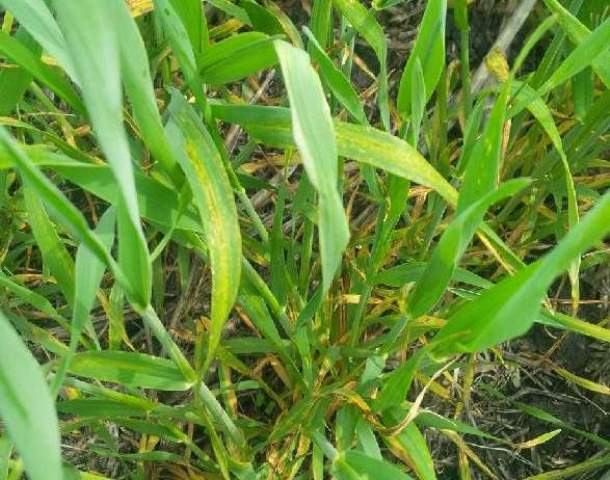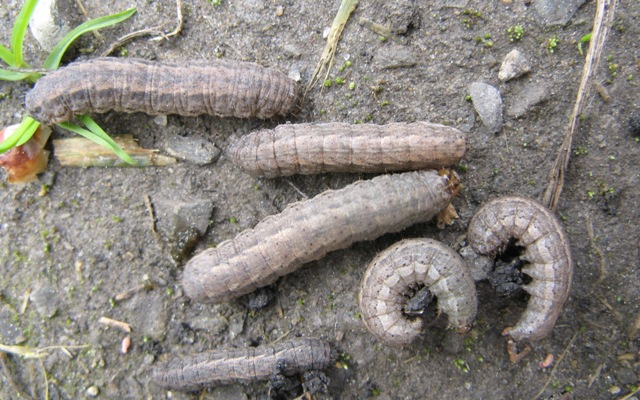Manitoba Insect & Disease Update: June 2, 2015
Summary
Flea beetles in canola and cutworms are the insects of greatest concern currently. Insecticide applications and some reseeding have occurred because of feeding by these insects.
Monitor crops for seedling disease while crop scouting as well.
Canola
Flea beetles have been a concern in many areas of Manitoba, with foliar insecticide applications and some reseeding occurring. In some of the earlier seeded fields the insecticide component of the seed treatments is no longer effective, and the plants have not yet reached the 3 to 4 leaf stage.
Natural Enemies of Flea Beetles: There are natural enemies of flea beetles. However the level of control they provide has not been documented to be as high as for some other canola feeding insects, such as diamondback moth and bertha armyworm. A wasp called Microctonus vittatae is known to parasitize flea beetles in Manitoba, but high levels of flea beetle kill because of this wasp have not been documented. Another species of parasitic wasp was released in Manitoba in the late 1970 and early 1980’s, with the hope that it would provide control of flea beetles in canola, but the wasps did not establish well.
Predators that have been documented feeding on flea beetles include lacewing larvae and damsel bugs. However, flea beetles would not be an easier prey item to catch for these generalist predators, and the amount of flea beetle consumed by predators is likely quite low.
Cereal Crops

Figure 1. Bacterial leaf streak. Source: Grower-submitted image.
Insects and Pathogens in Multiple Crops
Cutworms: Some cutworm problems have been reported, particularly in corn and sunflowers in the Central and Eastern regions. Larvae are starting to get larger, and do more stem clipping and visible damage.
If defoliation is noted during crop scouting and insects are hard to find, look in the soil around damaged plants to see if cutworms may be the cause. Older larvae of some species of cutworms may clip stems as well. In wet soils the larvae should be just under the soil surface. In drier soils older larvae will sometimes move deeper in the soil. A study on darksided cutworm found that in drier weather they can be found at a depth of 8 to 10 cm (3 to 4 inches) from the soil surface.
A reminder that cutworm damage can be very patchy, so where higher cutworm populations are found determine how extension the higher levels are and whether the whole field has economic levels or just a portion of the field.


Figure 2. Redbacked cutworm Figure 3. Dingy cutworm
Cutworms Needed: Research at the University of Manitoba is trying to determine the extent and species of parasitoids in our local cutworms. If cutworms are commonly found in a field, please contact myself (see contact information below) or contact or send samples to: Udari Wanigasekara, University of Manitoba, Entomology Department, 214 Animal Science Bldg., Winnipeg, Manitoba, R3T 2N2. Someone will come to the field to collect cutworms for the study as soon as possibly after being contacted.
If sending samples, please include with the sample the collection date, location, and crop the cutworms were collected from. Live cutworms are preferred. Place the larva plus some host plant material into a clean container. Do not include soil with the cutworms – it can damage the cutworm (abrasion, cuts), speeds desiccation, and introduces disease.
Seedling Disease: Seedling diseases can affect all crops, and young plants under stress (eg. frost, insect damage) are more likely to show effects from infection. The causal agents of seedling disease are varied and can infect under a wide range of conditions. The most common symptoms of this early season problem are damped-off of seedlings or wirestem, particularly in canola. A seed treatment can provide protection from these issues, but keep in mind that a seed treatment loses its efficacy two to three weeks after planting. There haven’t been many reports of seedling disease at this point, but plants have been under significant stress in the last week in many parts of the province. It is important to note that these pathogens have the most significant effect during the seedling stage, but many can also cause root rot later in the season.
Nearest Town |
GO Team |
Cumulative Trap Count |
Portage la Prairie |
Central Plains |
110 |
Swan River |
Valleys North |
79 |
Morris |
Red River |
75 |
Gilbert Lake |
North Parkland |
57 |
Durban |
Valleys North |
52 |
Birch Lake
Steinbach
Sifton
Kane
Tummel |
Valleys North
Eastman
North Parkland
Red River
North Parkland |
44
40
38
36
34 |
Low to moderate levels of diamondback moth adults may have started to arrive in the East and Central regions of Manitoba the week of May 3 to 9, and in the Northwest agricultural region of Manitoba the week of May 10 to 16. Numbers overall are not very high, but it appears some moths have arrived. How economical this is likely to become is hard to say and depends on many factors, including weather and natural enemies that may either overwinter in Manitoba or potentially move in on the same winds as diamondback moth. Look for signs of feeding and larvae of diamondback moth during regular field scouting. So far there have been no reports of larvae of diamondback moth being found.
Bertha armyworm: A reminder for those involved in the monitoring program for adults of bertha armyworm that traps can now be set up.
Compiled by:
- John Gavloski, Entomologist
Manitoba Agriculture, Food and Rural Development
Phone: (204) 745-5668
Fax: (204) 745-5690. - Holly Derksen, Plant Pathologist
Manitoba Agriculture, Food and Rural Development
Phone: (204) 745-4248
Fax: (204) 745-5690
To be placed on an E-mail list so you will be notified immediately when new Manitoba Insect and Disease Updates are posted, please contact John Gavloski at the address or numbers listed above.

